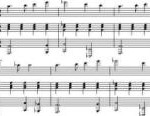
Pattern 1.7
Portamento of left hand
Creating sound continuity between two notes in the source and destination positions when left hand position changes and “two different finger numbers” are involved is called portamento. Portamento can be performed on single string or two neighboring strings and with hand moving on fingerboard either upward or downward.
7.1.1. when performing portamento involves moving left hand upward and changing finger from lower number to a higher one, (such as playing the note of G with third finger at fourth position after playing the note of B at first position with first finger of A string) this change must occur by shifting finger of lower number from source position to destination position, and placing finger of lower number on fingerboard quickly. (This example is performed by shifting first finger of E to first finger of B at fourth position and then quickly placing third finger of G at the same position).
7.1.2.when performing portamento involves moving left hand upward and changing finger from higher number to a lower one (such as playing note E with second finger at third position after plying note D with third finger at first position of A string) this change occurs by moving finger of higher number from source position to destination position and then quickly placing finger of lower number on fingerboard. (This example is performed by shifting third finger of D to third finger of F at third position and then quickly placing second finger of E at the same position).
7.1.3. when playing portamento involves moving left hand downward and with changing finger of higher number to finger of lower number (such as playing note A with first finger at first position after playing note C with second finger at second position on G string), this change should occur by shifting finger of higher number from source position to destination position and then quickly placing finger of lower number on fingerboard (this example is performed by shifting second finger of C to second finger of B at first position and then quickly placing first finger of A at the same position).
7.1.4. when playing portamento involves moving left hand downward with changing finger of lower number to finger of higher number (such as playing note C of second finger at first position after playing note D of first finger at third position on A string), this change should occur by shifting finger of lower number from source position to destination position and then quickly placing finger of higher number on fingerboard (this example is performed by shifting first finger of D to first finger of B to first position and then quickly placing second finger of C on the same position).
7.1.5. The general rules of portamento when occurring between two neighboring strings don’t differ from those of portamento occurring on a single string.
Notification 22: during practice, playing portamento begins with heavy tempo and the note of the shifting finger is played like a Ornament.









